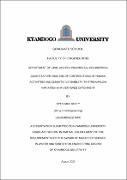Quantitative analysis of contributions of human activities and climatic variability to stream flow variation in river Rwizi catchment
Abstract
Climate variability and human activities have an impact on hydrological processes. Human activities influence rainfall runoff generation process while climate variability does not only affect runoff volume but also low and high flows, among others. River Rwizi in Uganda drains over 12 districts in the Western region has been reported on several occasions to be undergoing decline in its flows with subsequent drying of wetlands within the catchment. This study applied SWAT, a semi-distributed hydrological model to analyse response of runoff across River Rwizi catchment to human activities under changing landuse and landcover (LULC) types. Climate variability was assumed to be the residual of the attribution of results of the flow changes to LULC changes. Changes in LULC types were assessed using information based LULC maps for 1997, 2000, 2008, 2014 and 2019. SWAT was calibrated and validated using monthly data over the periods 2002–2008 and 2009–2013 respectively. Model performance was assessed in terms of Nash-Sutcliffe Efficiency (NSE). From 1997 to 2019, changes in LULC types were characterised by increase in cropland, forest and settlement by 26.09%, 0.87% and 0.35%, respectively. However, grassland and wetland decreased by 25.81% and 1.62%, respectively. NSE values for SWAT over calibration and validation periods were 0.50 and 0.71 respectively. These values indicate the acceptability of model results for assessing impacts of human activities and climate variability on River Rwizi flow temporal variation. River Rwizi flows of each month exhibited an increasing trend from 2002 to 2013. Contributions of human activities and climate variability to runoff variation were about 23.5% and 76.5%, respectively. Impacts of human activities on the stream flow were on average found to be larger during dry (14.7%) than wet (5.8%) season. Massive water abstractions especially during dry season and encroachment of wetlands make River Rwizi catchment hydrologically drier than it would be under minimal influence of human activities. These results indicate that climate variability is far much more influential in shaping River Rwizi flow change than human activities. Therefore, human activities which ensure sustainability of River Rwizi such as preservation of wetland and promotion of tree planting should be undertaken over the catchment.
Key words: Human activities, Climate variability, Streamflow, Rwizi Catchment, SWAT

